Overclocking has recently gained so much reputation. Many people with limited technical knowledge attempt to OC their computer components, particularly the CPU.
If you like to overclock your CPU, I suggest you to run some stability test. You may ask, “Why”?
The answer is, when OC the CPU, you like to obtain the utmost performance from the processor. You don’t like experiencing random crashes, blue screens, or various warnings.
Therefore, let’s get started and figure out how to tell if your overclock is stable.
What to Use to Perceive if CPU Overclock is Stable?
In the computer, the CPU is like a caged beast. When overclocking it, it’s like you set it free. So, before overclocking the CPU, first determine whether the CPU will remain stable or will cause havoc in the system.
You need to do a proper stress test to determine the stability of the processor. There are apps like Prime95, Cinebench R23, OCCT, Linpack Extended (for Intel), and Ryzen Master (for AMD). These apps help to torture CPU and figure out its limit.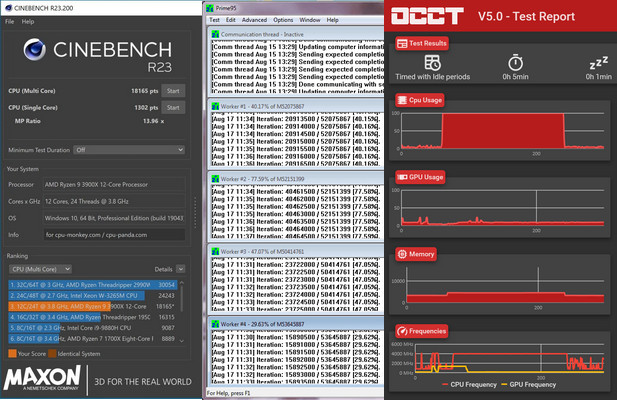
Moreover, you need HWiNFO or Core Temp to monitor the temps, usage, and voltages of CPU, at the time of stress testing.
So, gather the apps for monitoring and stress test. I will show the procedure to properly done the test, and how to check out the stability of CPU.
Check our latest post on can a CPU cause game crashes?
How to Test Whether The Overclock is Stable?
Overclocking is becoming more popular, and it is becoming easier to OC the CPU. Even though there are automated tools to OC your processor, it can also be done from BIOS.
Either you’ve overclocked automatically using tools or do it manually, it’s recommended to do some stress testing or benchmarking to the system. To test your CPU stability.
Follow these steps to Run Cinebench R23 benchmarks:
- Download Cinebench R23 from official website.
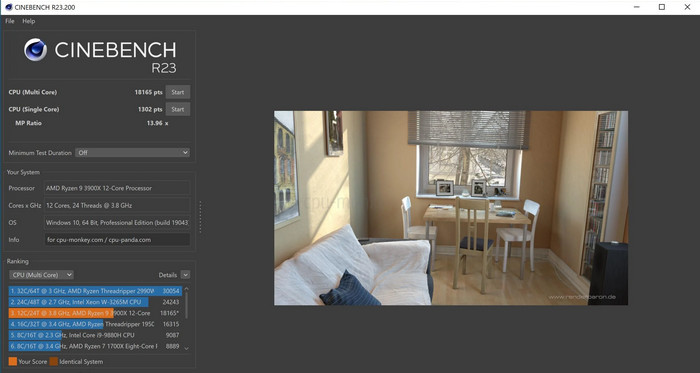
- Install and run the Cinebench R23 app.
- Close all the background apps.
- Click Start beside CPU (multicore or single core) to start the benchmarking.
In the app window, an image will begin rendering. Each specific block corresponds respectively to a single CPU thread. The specific test will operate for 10 possible minutes and afterward stop whenever the image rendering is complete.
If the first approach of running a Cinebench R23 is successful, it is preferable to run a few more benchmarking with the Cinebench R23.
Moreover, through this benchmarking if the system crashes then it’s better to consider that the overclocking is unstable.
After running some successive test with Cinebench, you should run proper test with apps like Prime95 or OCCT. I will show how you can stress test with Prime95.
With Prime95, you can test the PC components variously. There are Small FFTs which immensely torture your CPU and show CPU performance.
Also, there is Large FFTs, Blend FFTs and even Custom option. Which you can use to torture different component and test the limit. As it pushes the CPU performance to the edge, I think it’s one of the best stress testing tool.
Check out our latest post for can a Bad CPU cause no POST?
Follow these steps to run Prime95 stress testing:
- Download and Run Prime95.
- Choose mac number of cores in the “Number of cores to torture test”.
- Choose “Small FFTs” from “Run a Torture test box to torture the processor”
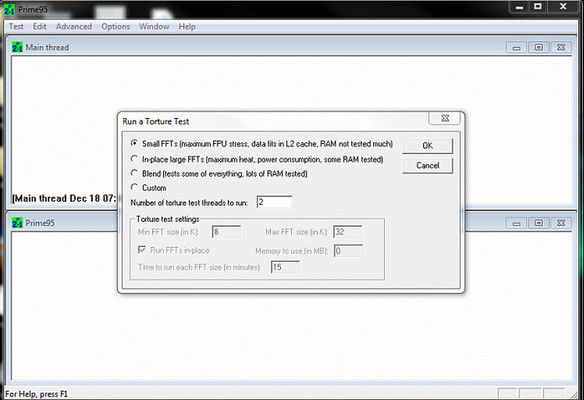
Small FFTs will start to test the CPU to its max. At the time of stressing, in case any cores fail to continue, then that core will stop and the tab will show not running. And if there is any issue like voltage and other, the app will immediately stop.
When I stress test my Ryzen 5 5600X, the Prime 95 crashes a few times, requiring me to adjust the OC in the bios. That could be your case as well.
However, assuming your CPU pass the first stress test, then run some more Small FFTs which just targets the processor. And for total determination of stability, run the stress test for 24 hours. Which confirms that the stability is absolute.
Note: In case, meet any critical temp or other activities that confirms that the CPU will be harmed. Then turn off the stress testing. Click the Test tab from the left menu, then click on Stop and OK.
As long as your CPU does not fail within the first 20 minutes, it is possible it will survive the extended torture. One more thing to remember, different stressing apps push CPU limit differently.
Moreover, at the time of stress testing you need to monitor the Temps, usage, and voltage carefully. Use HWiNFO to monitor the values. For the first 20 or 30 minutes, check the values with attention.
Check out our epic guide about how to tell if CPU is DOA?
Which Subject to Focus When Stress Testing CPU?
It’s obvious you set some target, when stress testing the CPU. When targeting overclocking, push your CPU to its maximum to find out how it performs and holds the stability. Also, there are other measures to focus.
Emphasis on these criterions when stress testing processor:
1. Make Sure The CPU Reaches 100% Usage
When stress testing, try to reach 100% of the CPU usage. You need to reach at the edge and monitor how it reacts. If it runs okay and stay stable at 100%, then it can be stated that the overclocking is a success.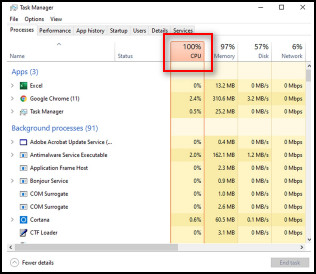
2. Monitor The Temp Carefully (Less Temp Indicate Better Stability)
Temp is a crucial value for stress testing. And carefully follow the number. If it crosses 75 or 80 degree Celsius and raises, then you need to stop the stress testing.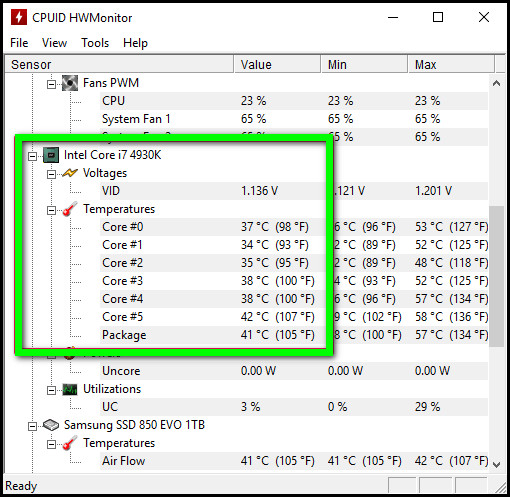
3. Research The Components
After successfully run Small FFTs, run some Large and Blend FFTs. To get an idea how other components responded with the testing. You demand adequate achievement from every component. Nobody desires bottleneck.
4. Don’t Afraid for Crashes
The sole purpose of overclocking and stress testing is to push the performance. If the system crashes, then you don’t have to be afraid. Cause modern system have safety measures which will shut down the component if there is chance for severe damage. So aim for crashes while stress test.
What Happens if the Overclock is Not Stable?
It’s better to accept that, not every attempt will be successful for OC. You might face many shifted performance from your component. Some apps may show unusual behaviors.
Moreover, encounter serious issues like sudden crashes, apps freezes, artifacting, and stuttering due to overclocking. You might encounter a Blue Screen of Death.
However, maybe you test your system with the Cinebench R23 or Prime95 and find out it’s stable. But after running on RealBench it crashes immediately. OCCT might put your system to crash instantly. Even the system might not run any game.
The theme is different apps push the testing limit differently. That’s why I personally recommended running some real-life benchmarks or stress testing. You can run some intensive games or rendering to do some actual tests.
FAQs
How do I know if my CPU is overclockable?
Overclocking is possible on Intel CPUs that begin with the letter “K,” such as the Intel Core i7 9700K. Additionally, overclocking is possible on any Intel “X” series processors. However, not all Intel CPUs can be overclocked or are unlocked.
How safely you can overclock a CPU?
There is no set limit on how much you can stretch your CPU because they are a little amount you can stretch your CPU as each one is a little different. However, if you want to use the overclock every day, the improvements ought to be negligible. That often means between 100Hz and 300Hz quicker with sufficient cooling.
Is overclocking unhealthy?
A computer’s processor, motherboard, and perhaps the RAM can all be harmed by overclocking. It may also void the motherboard warranty, in addition to voiding the CPU warranty
How much overclocking is too much?
Anything less than 10% ought to maintain performance. Your hardware might not even be built for overlocking if your system crashes or your games start acting up, or you could need to raise your machine’s temperature threshold.
Wrapping Up
The goal of overclocking is to extract every last bit of performance. OC also conduct extended stress testing to achieve the goal. Because you need the processor to be stable in all situations.
Furthermore, overclocking puts pressure on the CPU and other components and generates a lot of heat. So, it requires a better cooling system for your PC.
Additionally, while stress testing, it is best to perform some realistic challenge, such as playing a high-end game or running video rendering. That will give a better idea of how it will react and how stable the CPU will be in the future.




